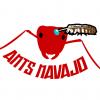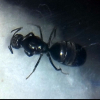I'm thinking of using this as a script for a short video essay about ants. I will use video of my colonies to illustrate the things I discuss in this essay and possibly some soothing music. I want to make a video that shares the things I have learned about ants and why I find them beautiful that even someone who think of them as pests might be able to understand and enjoy.
If there are mistakes or observations I might add I'm very open to suggestions!
The Ants Prepare for Winter
As August and summer slip away all of my colonies have become more frantic. They are all species that have evolved to deal with winter and the challenge winter poses for tiny creatures like ants is a great one. We tend to think of ants storing grain for winter, this appears in Bible stories, folk tales. People noticed ants could overwinter while many other insects lay their eggs, burry their larvae and then die.
But, only a few groups of ants eat seeds. Most ants prepare in other ways.
A queen ant can live for decades, and surprisingly keeping a colony warm through the winter tends to shorten, not extend her life. The winter is good for her. The ants have evolved not just to survive winter but to take advantage of it as an opportunity for rest.
Ants strive to increase their numbers before winter. More ants makes the whole superorganism more powerful. They also work to store fat and food in their gasters... but the main push is to get more ants raised to adulthood before the cold. Eggs and pupae may not make it through the winter. Larva sometimes can, but the best chance for each member of the colony is to be an adult ant.
That way when they emerge in spring they will do so in greater numbers.
Ant colonies become more efficient as they grow. More ants are able to be sustained on less toil. At some level ants know that numbers are strength and the focus is to feeding larva, tending eggs in the waning days of summer.
The more ants in a colony the more larva, eggs and pupae they can raise. When a colony is small eggs, larva and pupa are stored together as they all enjoy similar heat and humidity and they all require constant attention, to be turned, cleaned, feed every hour. It's just easier to have them all in one place. It's like a one room schoolhouse.
But, as a colony grows they seperate the young more. First isolating larva (who must be fed) from eggs and pupa who only need to be cleaned and turned. Then later they seperate the youngest larva from those closer to pupation.
In my largest colonies there are up to six different brood stations:
- eggs
- larva only slightly larger than eggs
- large larva who eat the most
- larva spinning cocoons
- pupa/cocoons
- callow recently eclosed ants
In other words, as the colony grows, the ants are able to specialize. This specialization is what makes larger colonies more efficient.
How do the ants transition from "brood all in a mixed lump" to "efficient factory with staging areas for each stage in development" ?
This seems like something worth learning from ants!
But back to the question winter. The colonies "know" it's coming and they make use of all of the food you can give them. Their most valuable resource is... other ants. Their best bet to survive hard times is to grow their numbers. Even matters like managing humidity become easier for a larger colony. With new colonies you must manage their humidity carefully and they are always at risk of drying out. But a large colony creates it's own microclimate.
Ants love to be close together. The whole colony huddled in the hollow of a log, or an underground nook. Sharing food & the work of raising the young. Nearly always each ant is touching two or more other ants. It seems to comfort them. But it's also very practical.
If one ant is startled you see the alarm spread through the mass of ants like a wave. This larger superorganism is a little more robust, a little smarter than the queen on her own, than the colony in the tough early days when there were only 5 or 3 or just 2.
And once the first cold snaps begin the ants will withdraw. Pull together. At this time there will be no more raising of young. Some species may keep larva, but they too will be in a suspended state of rest.
And not everyone will make it.
But, by building up her sisters, by making more sisters each ant knows that she has a better chance of making it through the hard times, to see the spring and start growing the colony again.
Edited by futurebird, August 23 2021 - 11:06 AM.
















